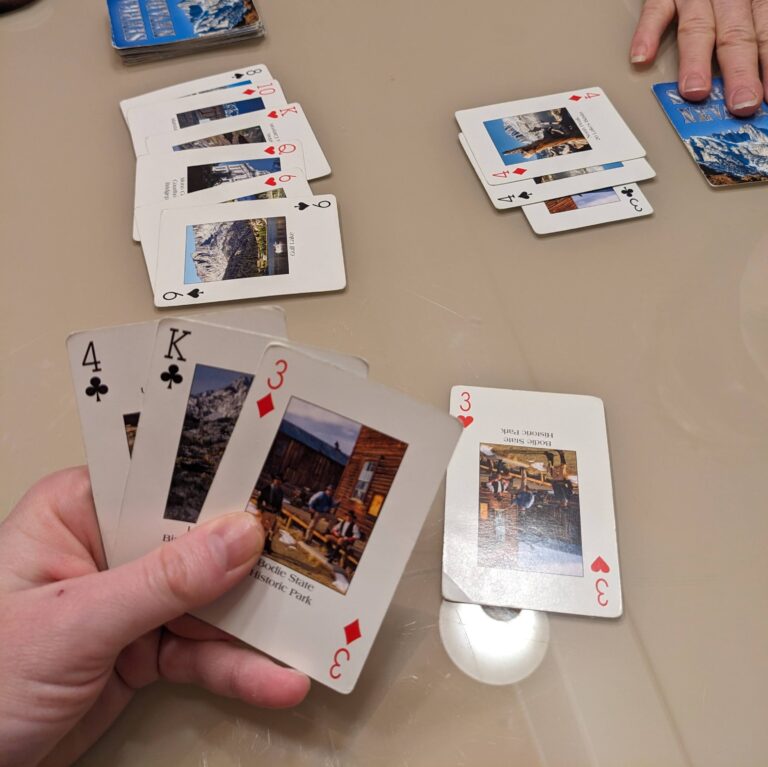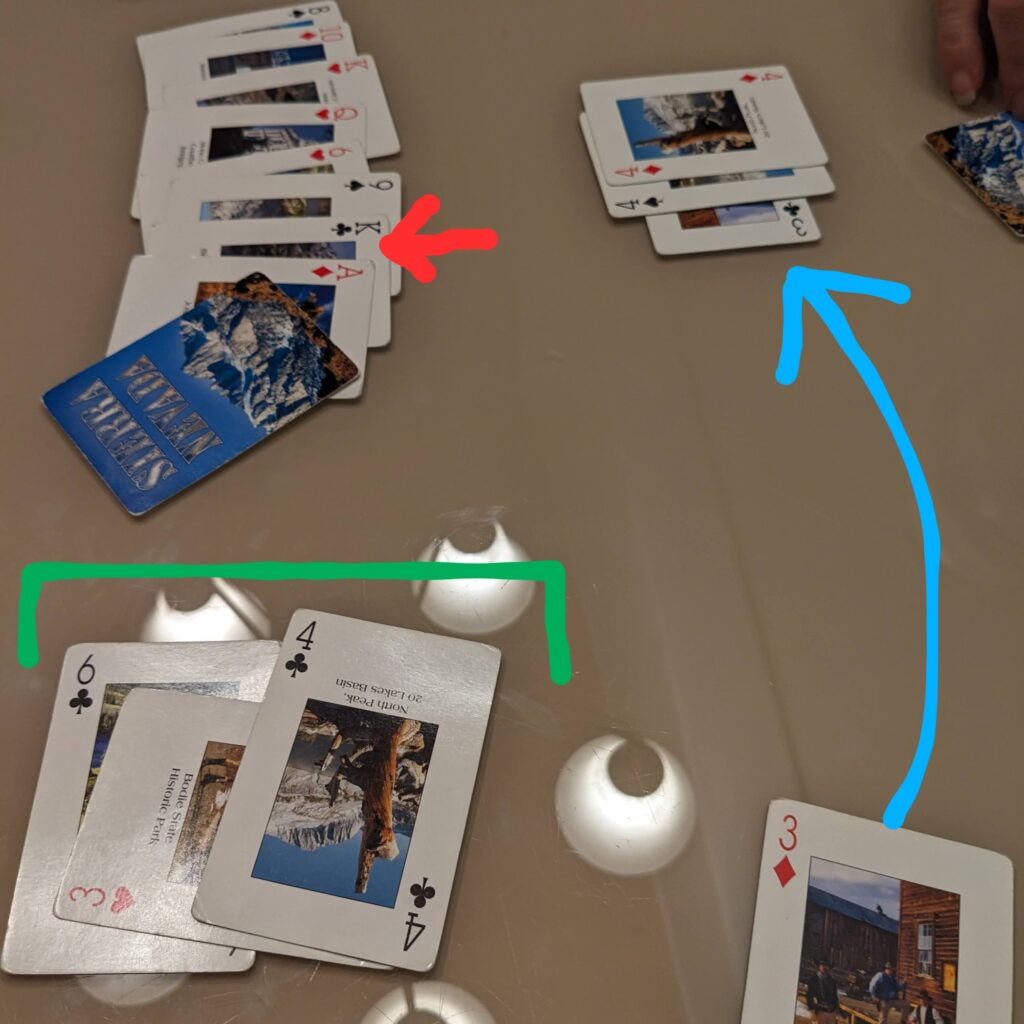End of the Page – A “wildly” fun card game with Rummy vibes
For approximately two years now, my family and I have been playing one card game more than any other: End of the Page. Similar to Gin Rummy, but with enough variation each game to keep things interesting, End of the Page relies on shifting starting hands, wild cards, and a unique scoring mechanic – the game is over when you reach the end of the page. Game going poorly for the scorekeeper? Rip that page in half! No one wants it to end? Tape a page together and keep going! (We have not yet tried a Mobius strip scorecard…)
Setup
So, how do you play? First take all the 2’s and Jokers out of the deck. If you are playing with two players, one deck is sufficient. For three players, you can either use one or two decks. If using more than three players, two decks is absolutely necessary.
Dealing and Determining the Wild Card for the Round
To begin, the dealer shuffles the deck and flips the top card over. This is the number of cards dealt (including the flipped card) to the person to the left of the dealer. Dealing continues for each player in this way: flipping the top card and dealing that number of cards to the player. If the flipped card is a 5, you deal out four more cards for a total of five. If the flipped card is a Jack, you deal out ten more cards for a total of eleven. A Jack means 11 cards in total; Queens are 12 cards, Kings are 13 cards, and Aces are 14 cards in total.
When the dealer gets to dealing to themselves, the top card flipped becomes the wild card for the round in addition to the number of cards dealt. The exception to this is if the flipped card is an Ace. If that is the case, the second card (or third card, if you keep drawing Aces) becomes the wild card. In short: Aces cannot be wild. The wild card remains on the table in front of the dealer until it is played in a set or run so that players can remember what is wild for that round.
Game Play: Getting Your First Set or Run
After dealing to all the players, the top card of the deck is turned over, and the first player may then draw the either revealed card or the top card of the deck, much like Gin Rummy. To play, a player must make either a set or suited run of at least three cards. If they have a wild card, they may use it to replace one of the cards in the set or run. If they have two wild cards, the wild cards must be separated by two “natural” cards. “Natural” cards are all cards that are not wild for the round. For example, if 5’s are wild, and a player has the 7, 9, Q, K of spades and two 5’s they cannot play 9, 5, 5, Q, K because the wild cards are not separated by two natural cards. They could play 7, 5, 9 and 5, Q, K. It is helpful to turn the wild cards sideways when playing a set or run down, so that the wild card is not forgotten when it comes to counting.
Playing on Other Player's Cards
Once a player has made their own set or run, they may then play on other player’s cards, but keeping the cards laid out in front of themselves for easy score-keeping – do not add your card directly to another player’s run or set. When there is nothing else they can do, the player discards and ends their turn. The next player may pick up either the top card of the deck or a card from the discard pile. If the card they want in the discard pile is not the top card, they must have two natural cards in their hand that will create either a set or a run with the desired card, and the card drawn from the pile must be immediately played along with the two natural cards in their hand.
Winning the Hand
Play continues until one player goes out by discarding a card that does not play and having no more cards in their hand. If they have no cards in their hand (all cards play) but they have no discard, they are “floating” and play continues until someone goes out.
What if someone gets incredibly lucky on their first turn and goes out immediately? There is no bonus to going out at once, unlike some versions of Gin Rummy. In End of the Page, every player has at least one turn: if the player to the left of the dealer goes out on their first turn, each player has one turn to play or discard high point cards before tallying the points. If the dealer goes out on their first turn, the game is over and it’s tough luck for the other players. Any points from cards left in a player’s hand at the end of the round are subtracted from the points of the cards that they have played.
Scoring
In this game, wild cards and Aces are worth the most, at 100 points each. Cards with a value of 8 and up (including face cards) are worth 10 points, and cards with a value of 7 and under are worth 5 points. Keep track of points on a piece of paper – the size of the paper determines the length of the game!
Ending the Game
The game ends when there is no more room to keep score on the paper – you have reached the end of the page!
Notes on Strategy
Due to the varied amount of cards in a starting hand and a rotating wild card, the game never feels stale; fewer cards does not necessarily make it easier to go out, and more cards does not necessarily mean a higher scoring hand. Because of the extreme point difference between Aces (and wild cards) compared to the rest of the cards, Aces can pose quite the conundrum. Do you discard an Ace if it doesn’t fit in your hand, risking giving your opponent extra points? Or do you hold on to it and hope to play it before your opponent goes out? These considerations can make for big point swings, allowing players who are hundreds of points behind to make huge comebacks.
Common Questions
Q: If 3’s are wild, and I have three of them, can I have a set of wild cards? A: You cannot play three 3’s as a set. They are all wild cards and fall under the rule where wild cards must be separated by two natural cards.
Q: Can I play my Ace low, using a wild card to bridge the gap between the Ace and the 3? A: Aces only ever play high, and wild cards cannot be played as 2’s.
Q: What if I play my wild cards as part of a set, and then find the natural cards. Can I play more than four cards in a set? A: Yes! For sets, you can play a wild card as a specific value, even if you end up having more than four cards of the same “value.” This is more common when playing with two decks instead of one.
Q: If I have one card left, and it plays, do I have to play it and be “floating?” Why can’t I just discard it instead, no one checks, right? A: Per the rules, if it plays, you must play it. Other players have the right to look at the discard to make sure that the card did not play, often played out by revealing the discard after going out.
____________________________________________
Example Game Conundrum
In the picture below, I am the dealer and 3’s are wild. My mom was dealt a 4, and has just played two 4’s with a wild card, discarding the 9 of spades. I have just drawn an additional 3, but cannot play yet, as I do not have two natural cards that can combine with a wild card to give a set or run. If I discard the 4 or the 3, my mom can pick it up, play it on her set, and go out. I must therefore discard the King of clubs.

On my mom’s next turn, she draws a card from the deck and discards the 6 of clubs.
On my turn: I am able to pick this up and play it with a wild card and the 4 of clubs. The other wild card cannot play on my own set, but I can play it as a 4 on my mom’s set. I do not have a discard, so I am “floating”.
My mom’s turn: she draws a card from the deck, and then discards an Ace, so as to not get caught with points (as it is very likely the next card I draw will not play and will allow me to go out).
My turn: I draw a card that does not play, allowing me to go out and end the game.
In the picture below, the red arrow is my original choice to discard the King of clubs. On my next turn I picked up the 6 of clubs that my mom had discarded, allowing me to make the set in green and then play my other wild card on my mom’s set of 4’s. Note the blue arrow indicates the card is playing on another hand, but I keep the card in front of me for score-keeping.
Score for the round: 210 points for me (2 wild cards at 100 points each, and two 5 point cards) and 105 points for my mom (110 points on the table – 5 points from her hand).

That’s it! Let me know if you have enjoyed playing this game, or if you have any questions about specific cases.
Have fun playing!
-Ms. Bitterwith